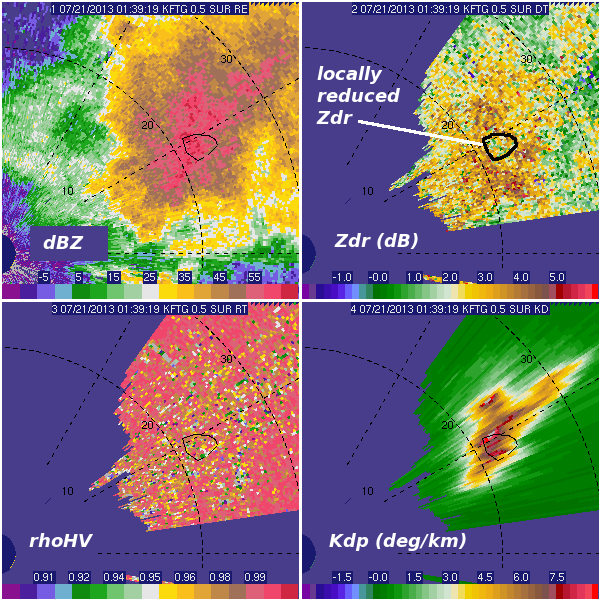High Kdp values observed by the CSU-CHILL and KFTG radars: 21 July 2013: Difference between revisions
Pat kennedy (talk | contribs) (Created page with "500px|center center center ...") |
Pat kennedy (talk | contribs) No edit summary |
||
| Line 1: | Line 1: | ||
==Introduction== | |||
Around 00 UTC on 21 July 2013, cumulonimbus clouds began to develop in the immediate vicinity of the CSU CHILL radar. By 0045 UTC, the sharply-defined, visually swelling cloud tops indicated that rapid storm growth was taking place ~30 km southeast of the radar site: | |||
[[Image:21jul2013 0045UTC CB pix crop.JPG|500px|center]] | [[Image:21jul2013 0045UTC CB pix crop.JPG|500px|center]] | ||
==0136 UTC RHI data== | |||
By 0136 UTC, the storms had moved out to a range of ~70 km from CSU CHILL. The following two-panel plot shows the data in the 158 deg azimuth sweep. The reflectivity structure contained a slightly domed top that extended to ~14 km AGL. Differential propagation phase shifts exceeding 8 deg / km were found in the lowest levels of the echo core. The radial velocity pattern showed that surface outflow maximized ahead of the echo core at ranges beyond 70 km. This leading-edge outflow was surmounted by a layer in inbound (negative in sign) radial velocities. Divergence was evident in association with the echo summit. | |||
[[Image:21jul2013 CHILL S RHI composite anot.png|center]] | |||
==0139 UTC dual Doppler analysis== | |||
The CSU-CHILL and NWS KFTG radars both began PPI volume scans at 0139 UTC. The following plot shows the Earth-relative horizontal winds synthesized at an analysis height of 2.5 km MSL. (Due to storm's ~70 km range from CSU-CHILL, this was the lowest usable interpolation height for gridding the CHILL data. The echo core region was associated with divergent flow at this height level. The solid red line marks the position of the 158 deg RHI plane. The blue dot marks the location where the maximum Kdp values were observed in the RHi scan shown in the previous section. | |||
[[Image:Anot 21jul2013 2.5km MSL ddop Z.png|center]] | [[Image:Anot 21jul2013 2.5km MSL ddop Z.png|center]] | ||
==Kdp observations by CSU-CHILL and KFTG== | |||
The following plots show the reflectivity and Kdp data from the PPI scans made by CSU-CHILL and KFTG. Kdp was calculated from the recorded differential propagation phase range profiles using the method of Wang and Chandrasekar (...). The maximum Kdp area was located at distinctly different ranges from the two radars: ~25 km from KFTG and ~68 km from CVSU-CHILL. The beam heights in the KFTG 1.3 deg elevation scan best matched echo core heights sampled in the CSU-CHILL 0.5 deg sweep. The data from each radar was interpolated to a common 0.5 km mesh X, Y Cartesian grid on the PPI scan surfaces. Due to the shorter range, smaller scale features are more evident in the KFTG data. The CSU-CHILL Kdp values reached ~8 deg / km, while the highest KFTG gridpoint value was 9.4 deg / km. | |||
[[Image:Anot 21jul2013 CHILL kdp.png|center]] | [[Image:Anot 21jul2013 CHILL kdp.png|center]] | ||
| Line 12: | Line 26: | ||
[[Image:Anot 21jul2013 KFTG kdp.png|center]] | [[Image:Anot 21jul2013 KFTG kdp.png|center]] | ||
==SOLO plots of the KFTG data== | |||
A more detailed view of the KFTG range gate (non-interpolated) data was obtained by using the NCAR SOLO display program. | |||
[[Image:21jul2013 KFTG .5deg SOLO anot 2.png|center]] | [[Image:21jul2013 KFTG .5deg SOLO anot 2.png|center]] | ||
Revision as of 15:44, 4 February 2014
Introduction
Around 00 UTC on 21 July 2013, cumulonimbus clouds began to develop in the immediate vicinity of the CSU CHILL radar. By 0045 UTC, the sharply-defined, visually swelling cloud tops indicated that rapid storm growth was taking place ~30 km southeast of the radar site:
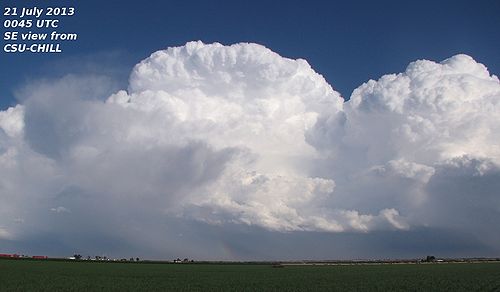
0136 UTC RHI data
By 0136 UTC, the storms had moved out to a range of ~70 km from CSU CHILL. The following two-panel plot shows the data in the 158 deg azimuth sweep. The reflectivity structure contained a slightly domed top that extended to ~14 km AGL. Differential propagation phase shifts exceeding 8 deg / km were found in the lowest levels of the echo core. The radial velocity pattern showed that surface outflow maximized ahead of the echo core at ranges beyond 70 km. This leading-edge outflow was surmounted by a layer in inbound (negative in sign) radial velocities. Divergence was evident in association with the echo summit.
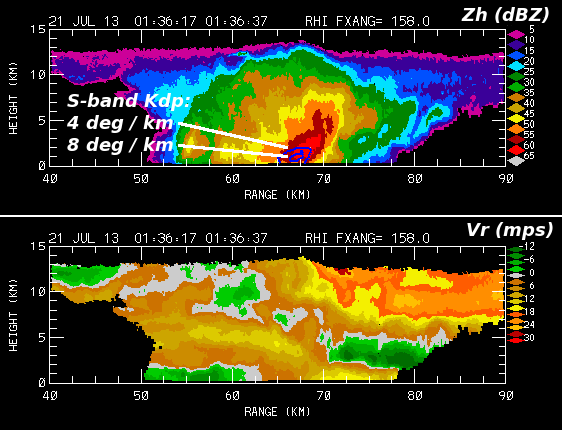
0139 UTC dual Doppler analysis
The CSU-CHILL and NWS KFTG radars both began PPI volume scans at 0139 UTC. The following plot shows the Earth-relative horizontal winds synthesized at an analysis height of 2.5 km MSL. (Due to storm's ~70 km range from CSU-CHILL, this was the lowest usable interpolation height for gridding the CHILL data. The echo core region was associated with divergent flow at this height level. The solid red line marks the position of the 158 deg RHI plane. The blue dot marks the location where the maximum Kdp values were observed in the RHi scan shown in the previous section.
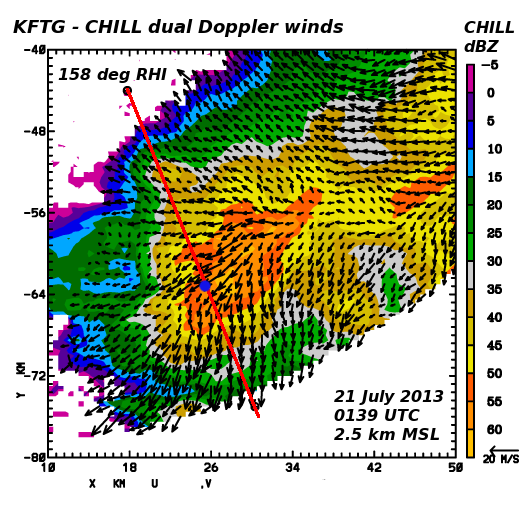
Kdp observations by CSU-CHILL and KFTG
The following plots show the reflectivity and Kdp data from the PPI scans made by CSU-CHILL and KFTG. Kdp was calculated from the recorded differential propagation phase range profiles using the method of Wang and Chandrasekar (...). The maximum Kdp area was located at distinctly different ranges from the two radars: ~25 km from KFTG and ~68 km from CVSU-CHILL. The beam heights in the KFTG 1.3 deg elevation scan best matched echo core heights sampled in the CSU-CHILL 0.5 deg sweep. The data from each radar was interpolated to a common 0.5 km mesh X, Y Cartesian grid on the PPI scan surfaces. Due to the shorter range, smaller scale features are more evident in the KFTG data. The CSU-CHILL Kdp values reached ~8 deg / km, while the highest KFTG gridpoint value was 9.4 deg / km.
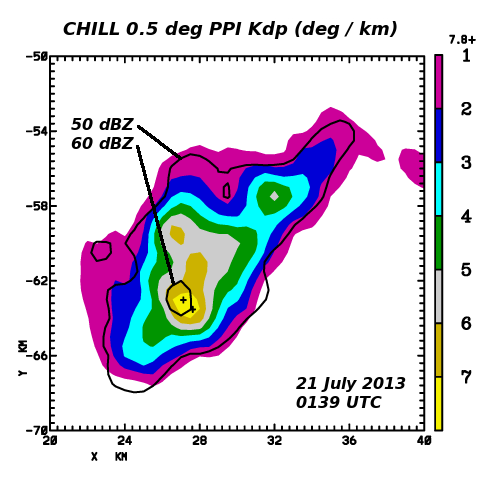
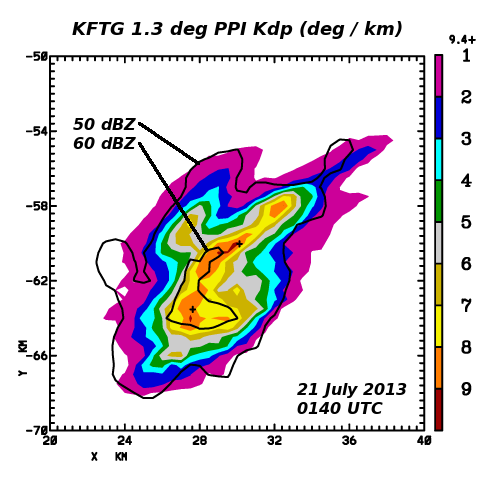
SOLO plots of the KFTG data
A more detailed view of the KFTG range gate (non-interpolated) data was obtained by using the NCAR SOLO display program.
